André Klein's Blog, page 26
September 19, 2012
How To Create Ebooks With Open Source Software: #3 Conversion & Preview
Welcome to the third and final part of our short ebook creation guide. After going on and on about the importance of styles, today I’ll finally show you how to get your ebook converted to MOBI or EPUB, files that you can easily upload to the Amazon ebook store, B&N etc.
2 Free Tools You Need To DownloadThere are many tools with which you can create ebook files and preview how they appear on various devices. Here are my two favorites, and yes, they’re both free:
Calibre – the ultimate ebook conversion, organization and management suite
Kindle Previewer – little tool to preview your finished ebook on various Kindle devices
Step 1: Saving Your Ebook As HTMLAlthough Calibre accepts ODT (openoffice format), I have had better results with saving my books in OpenOffice first as .HTML.

Go to File > Save As

From the Save as type drop-down menu select HTML
2. Loading Your Ebook Into Calibre
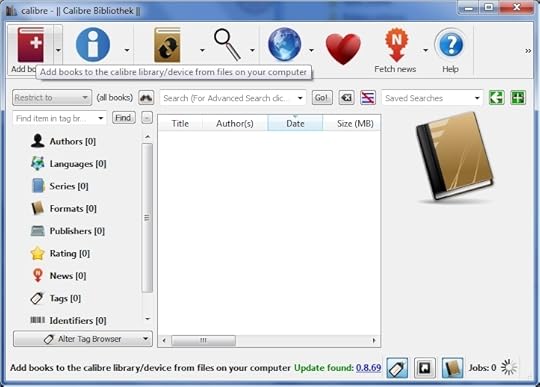
Launch Calibre. To add a new book click on the red book icon or Add Book

In the dialogue, navigate to the location of your HTML file, select it, click Open.

Wait a second while Calibre pulls the file into its database…

There it is! In the next step, click on the blue icon Edit Metadata to add some more information.
3. Adding A Cover and Author Information

Here we can add/change all kinds of things. For now, pay attention to two things: The cover & author information.
As usual, Calibre messed up my name, turning the é into a ?, also we should add a cover. The cover can be changed by clicking on Browse in the Change cover section. The author field can be edited by selecting it.

I’ve quickly done that. Also note that in the upper hand corner, we see all the various formats associated with this publication. Right now it exists only in ZIP (Calibre converted the HTML to zip), but this is soon to change… When you’re done with adding/changing metadata click OK.
4. Convert Your Ebook For Amazon Kindle
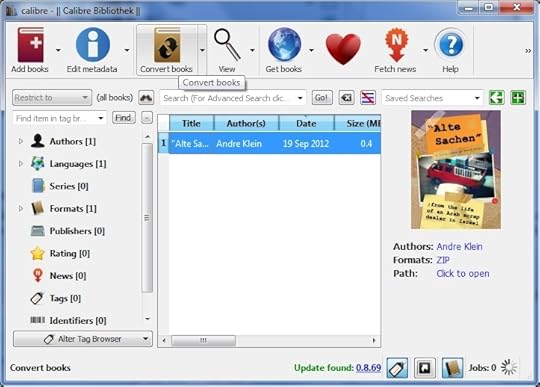
To convert our book, click on the third icon from the left Convert Books, and you’ll see this:

This is the conversion window. Calibre provides us with tons of option for getting the best results. In the beginning you won’t need most of these settings. Here are some essential things to look for:
In the upper right corner, select the OUTPUT format, for example, if you want to create a MOBI for Amazon Kindle, select MOBI.
Next, let’s take a look at the Look & Feel panel:
Some things you might want to check here are:
Disable Font Size Rescaling: prevents Calibre from using the same font-size for all your paragraphs (headings not affected)
Remove Spacing Between Paragraphs: This will remove “empty lines” and put all your paragraphs together, allowing you to set an indent:
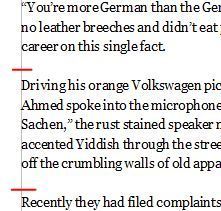

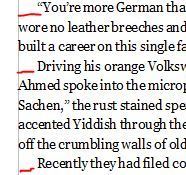
Another interesting setting is Smart Quotes which converts all your quotes:

Now, let’s take a look at the Structure Detection panel:

Calibre will automatically try to detect chapters and insert pagebreaks (before Heading 1 and 2 styles! ) If you’d also like to have these breaks before Heading 3 you could change the line:
//*[name()='h1' or name()='h2']
to something like:
//*[name()='h1' or name()='h2' or name()='h2']
Or maybe you’d like to have breaks only before Heading 1 styles?
Change the code to:
//*[name()='h1]
Simple, isn’t it?
Next, let’s take a look at our Table Of Contents panel:
By default, Calibre will not generate an automatic Table Of Contents. You have to tick “Force use of auto-generate Table Of Contents”
And now, let’s do some magic with our styles again. We can easily set the levels (hierarchy) of our Table Of Contents to our styles:

This sets Heading 1 to Level 1 in my Table Of Contents, for example.

Now I’ve set Level 2 and 3 to Heading style 2 and 3, respectively, which will produce a three-level TOC like you’ve seen in our last tutorial:
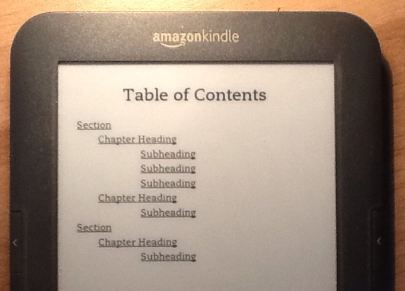
Once you’re done with your Conversion Settings, click OK.

In the lower right corner of your calibre window you’ll see the Job of converting your ebook. Note, that as long as the book isn’t converted, the only Format you’ll see is ZIP.
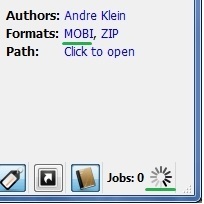
Once it’s done, it’ll say 0 next to Jobs, and you’ll see MOBI under formats.
To preview your finished file, click on Click to Open, which will show you the directory of this ebook.
5. Previewing Your EbookIf you have installed the Kindle Previewer you can now open the MOBI file and check if everything is alright:

Looking good? Great! Now you can upload your MOBI to the Kindle store.
P.S.: The above process is exactly the same when you’re converting to EPUB.
— END OF PART #3 —
This was the last part of our tutorial series. There is of course much more to say, so if you’d like to know more, I’d recommend the following: Ask your question in the comments section below, and if there’s a demand for more, I’ll collect all your questions and make another Q&A post.
—
Was this tutorial helpful? Did I miss something? What do you think? Leave a comment!
-

 About the author:
André Klein was born in Germany, has grown up and lived in many different places including Thailand, Sweden and Israel. He has produced two music albums, performed and organized literary readings, curated an experimental television program and is the author of various short stories and non-fiction works.
About the author:
André Klein was born in Germany, has grown up and lived in many different places including Thailand, Sweden and Israel. He has produced two music albums, performed and organized literary readings, curated an experimental television program and is the author of various short stories and non-fiction works.
September 15, 2012
How To Create Ebooks With Open Source Software: #2 Structure & Flow
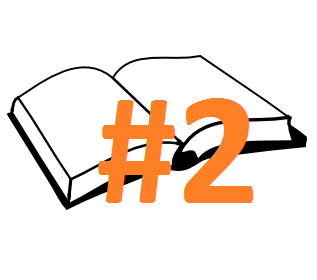 Welcome back to the second part of our little ebook making course. For those who missed it, here’s a link to the first part: # 1 Manuscript Styles
Welcome back to the second part of our little ebook making course. For those who missed it, here’s a link to the first part: # 1 Manuscript Styles
Some of you might wonder why we started out by talking about styles. Maybe they seem to make certain formatting tasks a bit more convenient, but apart from that, what’s the connection to ebooks?
Good question!
Styles Generate StructureBy using the predefined heading styles we can automatically order our document, simplify navigating through a long document and even create interactive TOC (Table of Contents) sections for ereading devices such as the Kindle or Nook.
Let’s have a look! (Hey, that rhymed!)

This is a simple document containing three different headings in three different styles. (I colorized them for you to make it easier to differentiate) Apart from the “modify one, change all” convenience we discussed last time, styles bring structure into your document.

To see this structure go to View > Navigator

On the left side you can see the Outline of our document. Not only does it allow you to click these headings and quickly jump to the chapters (or headings), they are also automatically in hierarchical order, which is perfect for bringing structure into long documents. Check out the following example:

In this example I used Heading 1 styles for my Section headings, Heading 2 for my Chapter headings and Heading 3 for my Chapter Subheadings. By simply applying these pre-configured styles, we suddenly have the skeleton of a book!
Table Of Contents: An Interactive Map for ReadersWhen the great history of trouble is written, my family will stand extremely high in the table of contents. - Allan Sherman
In the conversion process, which I’ll talk about in future units of this course, these outlines can be easily converted into clickable/tappable TOCs. Here are a few examples:

This is how it looks on an Amazon Kindle device.

This is how it comes out on an iPad (Kindle app)

And even, although this is not directly related to our tutorial, PDFs become interactive this way!
(To enable it, click File > Export to PDF and tick “Export bookmarks”)
Quick Summary About StylesWe’ve learned a few things now about styles. Time for a quick recap:
styles make formatting large numbers text elements simple and consistent: “modify one, change all”styles bring structure into your document that helps to keep an overview while writingstyles can be used to generate clickable/tappable TOCs on ereading and mobile devices or in PDFsBut wait a second…That’s not all! In fact, it’s not even the tip of the iceberg. To illustrate another benefit, let’s do quick comparison between ebooks and books.
Ebooks Don’t Have Pages, Or Do They?One of the more confusing aspects for people who are getting into the ereading world (whether as a publisher or reader) is the “absence” of pages. To be more precise, pages aren’t exactly non-existent, but they behave very differently.
On a printed page in a book, the words are fixed in a certain position, size and formatting style. With ebooks, all of these factors are dynamic. When I read an ebook on an ereader, I can choose what font-size I like, how much space I want to have inbetween my words, etc. Here’s the settings panel from a Kindle ereader, for example:
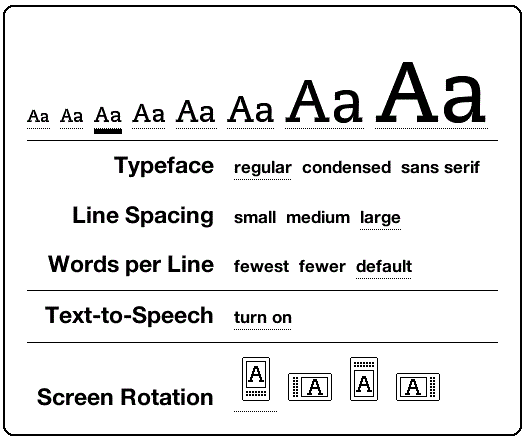
That’s all great. But since at the smallest font-size, the ereader device displays a lot more text on one “page” than at the biggest, pages lose their static definitions which, for example, makes page-numbering difficult.
But there’s another aspect of bookmaking that has to be revisited under this aspect.
Of Page Breaks And Broken FlowsI don’t think there is anything wrong with white space. I don’t think it’s a problem to have a blank wall - Anna Freud
In every book we’ll find a phenomenon that bookmakers call page breaks.
Here’s an example of a page break in a physical paperback book:

As you can see, on page 176, the text-flow breaks and the book continues only on the next page, starting with a chapter heading. This page break and the nice white space it creates lets the reader’s eyes rest before continuing. Also, it’s at these page breaks many people lay a book aside, starting their next reading session from the new chapter heading.
How do we accomplish this in an ebook which has no fixed pages, where the same amount of paragraphs could fill half a page or three?
Yes you guessed it…by using Styles!
Let’s take a look again at our manuscript in Open Office:
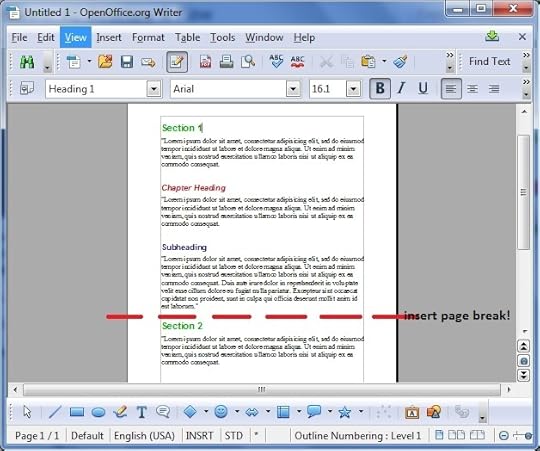
I’d like to have a page break just after the subheading and before the new section starts. Here’s what many people would do:

Yes, people would just hit enter 3 times, 6 times, 20 times, however many times it takes to get the cursor to the bottom of their page. It’s a bad habit from the age of the typewriter and it unnecessarily complicates digital text processing.
A BETTER (BUT FAR FROM PERFECT) ALTERNATIVE:
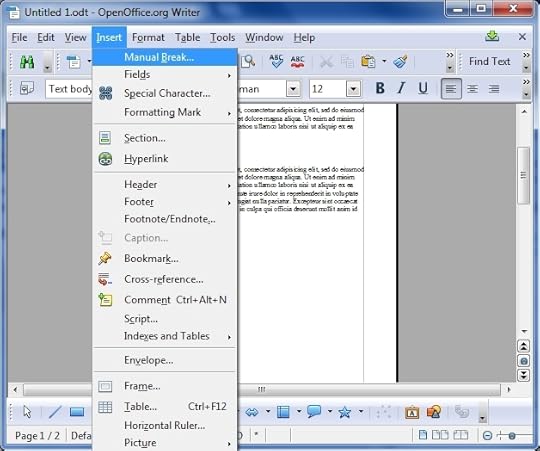
When you’ve finished writing your paragraph go to Insert >Manual Break or hit Shift + Enter
This will tell the text to stop its flow and continue on the next page.

That’s exactly what we wanted! But what if there are dozens of different sections? We don’t want to insert all these page breaks manually! Styles will help us out, once again. Remember how to modify the Heading 1 style we chose for our section?
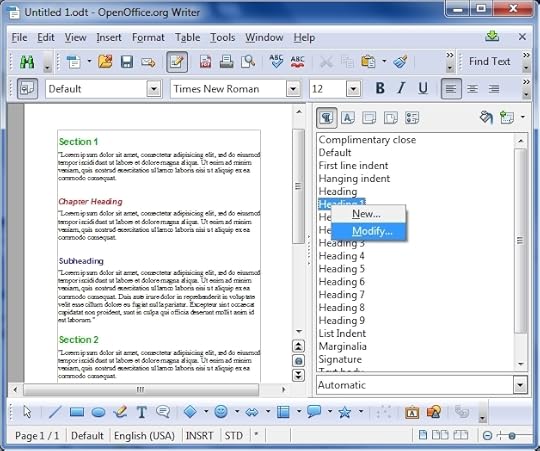
Yep. Open the Styles and Formatting window (shortcut: F11) and right click on Heading 1, then select Modify.

In the middle of the Text Flow tab where it says breaks, tick the Insert box and hit OK. Now Open Office will insert a page break whenever a new section starts, even if you haven’t written the section yet.

As you can see in the above preview, there’s now a page break before each Heading 1 section (green) appears, no matter how many chapters or sub-chapters there are, or how long they are. The Heading 1 always comes out on top of a new page, just from making the simple setting described above. Since this is a dynamic setting relative to the appearance of the headings, not to the length of the paragraphs or pages we see in Open Office, the same principle can be applied to ebooks.
— END OF PART #2 —
In the next post, we’ll (finally) take a look at the conversion process from Open Office format to ebook format.
—
Was this tutorial helpful? Did I miss something? What do you think? Leave a comment!
-

 About the author:
André Klein was born in Germany, has grown up and lived in many different places including Thailand, Sweden and Israel. He has produced two music albums, performed and organized literary readings, curated an experimental television program and is the author of various short stories and non-fiction works.
About the author:
André Klein was born in Germany, has grown up and lived in many different places including Thailand, Sweden and Israel. He has produced two music albums, performed and organized literary readings, curated an experimental television program and is the author of various short stories and non-fiction works.
September 12, 2012
How To Create Ebooks With Open Source Software: #1 Manuscript Styles
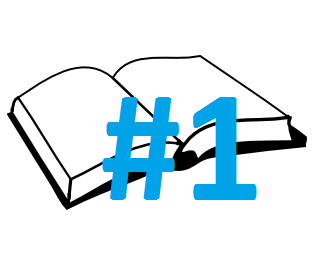 We live in a time where almost anyone on the planet can create, publish and sell books (or other media) without any insurmountable technical or financial preconditions.
We live in a time where almost anyone on the planet can create, publish and sell books (or other media) without any insurmountable technical or financial preconditions.
There are already many tutorials out there how to make ebooks. Each one has its own approach. In this short series, I would like to share my own way of creating ebooks while focusing on the open source aspect so that anyone who might be interested can follow the steps of creating, publishing and selling ebooks with freely available software.
What To Write AboutMany how-to-make-ebooks guides start by telling you not to write a single word before you do your “market research”. Apparently, the idea is that if you carefully “construct” something, the likelihood that it’ll sell is significantly higher…
It’s not that this is necessarily false, but I find this approach terribly boring and short-sighted. If you are desperate for money, by all means try creating ebooks for specific niches and demands. If, however, you want to share your own personal ideas and create truly unique writings and ebooks, this might not be the best path to pursue, because if you do something radically unique you’ll have to step boldly into the unknown like my friend George’s pioneers.
In other words: if you’re more interested in income than artistic (or academic) expression, have a look on the Amazon Kindle Store bestseller list and try to create something similar. Non-fiction books in the how to category are a good place to start. I also tried there first, just to test the waters and when I saw that it was possible to actually sell my writings there, I brought out more precious and personal ebooks.
In any case, the following guide is designed in a way that you can use it to create ebooks with whatever content you like!
It’s not my job to tell you what to write or how to write, but to illustrate how one might approach formatting, packaging and publishing.
Writing Word By Word: The ManuscriptIt’s so fine and yet so terrible to stand in front of a blank canvas - Paul Cezanne
Each book begins with words on a page (or screen). In this section we’ll talk about (one possible way) to create a manuscript that can later be turned into an ebook, and sold on stores like Amazon or iBooks.
Let’s start with a few general notes:
 PDFs are great, but creating ebooks in formats specifically designed for ereading devices such as Kindle, Nook, Kobo, iPad etc. is even better. (PDFs have fixed page layouts and don’t scale down very well on smaller devices, which leads to a lot of unnecessary scrolling and swiping)By publishing your ebook in stores such as Amazon, iBooks, Barnes & Noble you’ll get a lot more exposure (and sales) compared to offering paid downloads from your website only.It’s possible to convert finished PDFs to the ebook formats required by these stores, but it’s even better to create manuscripts that from the beginning will seamlessly convert!
PDFs are great, but creating ebooks in formats specifically designed for ereading devices such as Kindle, Nook, Kobo, iPad etc. is even better. (PDFs have fixed page layouts and don’t scale down very well on smaller devices, which leads to a lot of unnecessary scrolling and swiping)By publishing your ebook in stores such as Amazon, iBooks, Barnes & Noble you’ll get a lot more exposure (and sales) compared to offering paid downloads from your website only.It’s possible to convert finished PDFs to the ebook formats required by these stores, but it’s even better to create manuscripts that from the beginning will seamlessly convert!There are many ways to write and create an ebook which will convert easily to MOBI or EPUB (two of the popular ebook formats used by Amazon, iBooks, etc). In the past I’ve had success with two methods:
composing the manuscript in an HTML editor such as Kompozerwriting and preparing the manuscript in Open Office’s WriterThe first option is great, because it gives you full control over the layout, but if you shy away from working with code directly, and have never looked at the brackets and semicolons of HTML or CSS before, the second option will do fine.
Using Open Office’s Writer As Manuscript MakerEveryone knows how to use Microsoft Word, or Open Office Writer (which is basically the same, only free). That is, everyone uses this software to write letters and recipes, etc. But in my experience many users are unaware of a simple but powerful feature: Styles.
Working with styles will make your writing and layouting life a lot easier, not only, but especially when you want to make a professional ebook.
But what are styles? And why should we bother? Let’s look at the actual software…
Reason #1: Not Using Styles Wastes Your Precious Time

It’s a new document. Not much to see here..Let’s start writing!

Okay, so there’s a title, and then there’s a very short paragraph. But the title is too small. Let’s make it bigger! Here’s what most people do to change that: they just mark the title and change the font-size.

“Why is that so bad?” you might ask. “I’ve always been doing it like that and you have the nerve to tell me not to?”
Well, instead of explaining it, let me show you… Let’s just say we continue in this manner by putting in a second title and a second paragraph and setting it to the same font-size.

The result would look like this:

Can’t see any problem with that? Me neither. Seems too look alright. But suddenly after writing a lot of titles and paragraphs you decide that 18 is a bit too big, after all, and you’d like to dial it down to something more modest, let’s say 14.
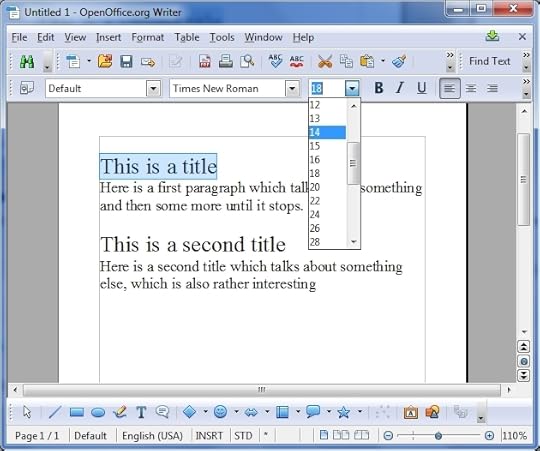
So we go the old route of marking and changing font sizes. First we do it for the first title, then for the second, then….you see the problem? If a book has 400+ titles you’ll have to mark them all and change their font-size by hand! Fun, huh?

Life is too short and beautiful to be wasted by repetitive tasks that can be automatized.
Reason #2: Modify One, Change All!Don’t change font sizes manually. Instead, use styles! - Mr. Skeleton
So far so good, but we still didn’t talk about what styles actually are and how to use them!
Okay, so let’s just start again from the beginning. To reset all your font-sizes, colors, etc. just mark the whole text and select Format > Default Formatting

this will reset everything and we’ll be back to square one:

Okay? Now let’s change our title font size the styles way:

Mark your title, and then select Heading 1 from the styles selector. Then do it for the second title, too:

Now, both of the titles have the attribute of “Heading 1“. It’s a bit bigger, but what’s the difference from just changing the font-size? Let’s imagine the above scenario again where, after writing a dozen titles and paragraphs, we have a sudden change of heart and want to change the title font sizes…
Instead of doing it manually and ending up like the skeleton above, we just need to change the attribute for “Heading 1” once. Here’s how:
First, go to Format > Styles and Formatting:

It will bring up a new little window containing all your style definitions:
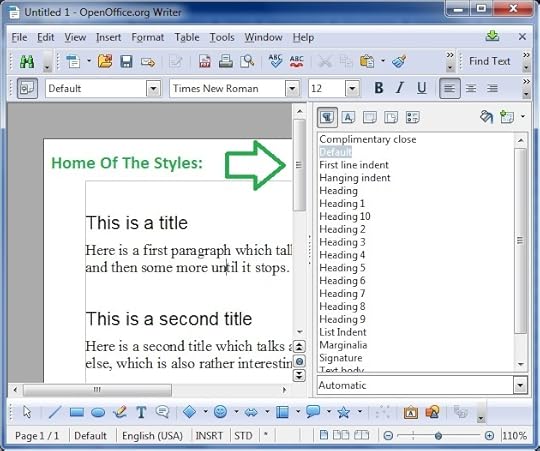
To change a style, do a right click on it and select modify:

This will bring up another window where you change everything about the selected style!

Whew! That’s a lot of tabs and options. Don’t worry, you don’t need to know what they all do. First of all, let’s focus on the Font settings tab:

This should look familiar, right?
Just change the font-size and typeface to something else (note: changing the font from Arial to Times New Roman, etc. will not have any direct effect on most ereading devices, where the hardware determines the font, not your document! For now, you can ignore these settings.)
When you’re done, hit save and all your “Heading 1″ styles will be updated.

In my example I set the style’s typeface to italic and all my “Heading 1″ titles immediately changed to italic. Even if you have 400+ titles, they’ll all receive and reflect their settings based on what you set in the “Heading 1″ style”.
In other words: Modify once, change all!
Here’s another example of a manuscript with a couple of titles.

Now I want to have them all centered. Since they’re all set to “Heading 1″ style, I simply open my styles panel…

…modify the Heading 1 style…

… in the popup I open the tab which says Alignment, select Center, hit OK….

…et voilá! Everything centered with one click.
You get the idea? Whatever formatting attributes you want to apply to your manuscript, don’t do it manually. Instead, use styles! We just talked about Heading styles so far, but the same principle can be applied to paragraphs as well.
— END OF PART #1 —
In the next post, we’ll look at yet another powerful reason for using styles and how you can create your own customized styles. And yes, we’ll also talk about converting our manuscript.
—
Was this tutorial helpful? Did I miss something? Was it too difficult to follow? What do you think? Leave a comment!
-
nook photo: CC by allaboutgeorge

 About the author:
André Klein was born in Germany, has grown up and lived in many different places including Thailand, Sweden and Israel. He has produced two music albums, performed and organized literary readings, curated an experimental television program and is the author of various short stories and non-fiction works.
About the author:
André Klein was born in Germany, has grown up and lived in many different places including Thailand, Sweden and Israel. He has produced two music albums, performed and organized literary readings, curated an experimental television program and is the author of various short stories and non-fiction works.
September 11, 2012
Dave Nicholls: Technology has changed my working life in a massive way
The following interview is part of an interview series in which we feature education professionals from a variety of different fields in order to highlight individual efforts and creative solutions to education in the 21st century. If you want to participate simply write down and send your answers to the five below questions to info {at} learnoutlive.com and include a picture of yourself. (Please note that we reserve the right to not publish all submissions)
1. Who are you and what do you do in education?
 My name is Dave. I am an independent English teacher who uses Skype to deliver online lessons to students and pupils of different ages. Most of my students are Russians, and this is because I have plenty of experience working ‘on the ground’ in Moscow. I have a website which actively promotes my services on both English and Russian platforms. I publish all my lesson plans, quizzes, grammar explanations and youtube videos on the site, and I am looking for other teachers who enjoy doing the same and would like to collaborate on some joint projects.
My name is Dave. I am an independent English teacher who uses Skype to deliver online lessons to students and pupils of different ages. Most of my students are Russians, and this is because I have plenty of experience working ‘on the ground’ in Moscow. I have a website which actively promotes my services on both English and Russian platforms. I publish all my lesson plans, quizzes, grammar explanations and youtube videos on the site, and I am looking for other teachers who enjoy doing the same and would like to collaborate on some joint projects.
2. Describe a typical work day in your life!
I get up at half past seven and make myself a very very strong coffee. Lessons start at 8 am and usually finish at 11am. Then I send off all the homework as well as lesson feedback documents to the students, and prepare myself for the second shift which usually starts at 2pm and finishes at 7pm. I will often have an hour break somewhere because someone is on a business trip or holiday, or some other appointment. During my breaks I usually send homework and make youtube videos or lessons to put on the website. They are very useful because I set them as homework for the students. So, I always have a massive amount of material to use with any new students, and that material is available to everyone for free download on my site. After finishing all lessons, I quickly send off any invoices which are necessary, and then spend the evening reading to my daughter. The only problem with this work is that at the end of the day I have no voice left to read a story to her! This is why I insist on the student doing the majority of the talking in each class!
3. In what way has technology in general and the net in particular changed your work?
Technology has changed my working life in a massive way. Just 2 years ago I was still in Moscow, commuting as much as 4 hours every day, and planning ALL my lessons with just pen and paper. Everything ended up in the bin. Now I don’t commute, and everything that I plan is saved, edited and then added to my website. It’s such an advantage to have all that you have ever planned, organised into a special place on your own website. And it’s certainly more convenient, for both myself AND the student, to have no journey to lessons. So technology has made the whole learning process easier for both parties.
The net has changed the way I conduct my lessons. I now place a much heavier emphasis on listening exercises for homework. Working online has opened my eyes to video sharing platforms like youtube or smotri.ru which enable the student to watch some classic TV shows for free and at home. With such easy and free access to great listening material (dialogue in TV shows is both realistic and engaging) it is a shame not to use it. So now I write grammar, vocabulary and comprehension questions for popular TV shows, like ‘The IT Crowd’ and ‘Sherlock Holmes’, so that my students can download the material and use it for homework. During the class students will often speak to me about the show and repeat a lot of the material for maximum retention. In addition to the lesson plans, I love making my own youtube videos for both vocabulary and grammar explanations. It is certainly an advantage to have your grammar explanations on youtube. The student always comes to the lesson with your explanation already in his mind, and so is already prepared for the difficulties.
4. What challenges do you see for education in the future?
Online schools will face competition from independent teachers setting up their own websites. It is getting easier and easier for people with no technical knowledge (or HTML knowledge) to set up their own websites. And it is also rather cheap. And lastly, it is easy for any teacher who is producing new materials to get online attention. They need only publish their materials in the right groups on facebook, livejournal, youtube, myspace etc… and they will pick up a following. I see this as a positive step forward, as often private teachers offer higher quality services and at more reasonable prices.
The main challenge for teachers and students is keeping up with the new software and tools available for enhancing the learning process. There are so many new teaching platforms and programs that it is hard to try them all out and see which ones suit your methods. Also, there are so many free resources out there in cyberspace. The challenge is to use such a vast amount effectively. Again, I see this as an advantage. There is such a wide selection available you will be sure to find something which will interest the student.
5. Where can we find you online?
I can be found on facebook, youtube, vk.com, squidoo, linkedin, quizbiz, Skype and on my own website
Skype name = davetefl
www.skype-lessons.com/lang-en/

 About the author:
André Klein was born in Germany, has grown up and lived in many different places including Thailand, Sweden and Israel. He has produced two music albums, performed and organized literary readings, curated an experimental television program and is the author of various short stories and non-fiction works.
About the author:
André Klein was born in Germany, has grown up and lived in many different places including Thailand, Sweden and Israel. He has produced two music albums, performed and organized literary readings, curated an experimental television program and is the author of various short stories and non-fiction works.
September 9, 2012
Now Interviewing Education Professionals
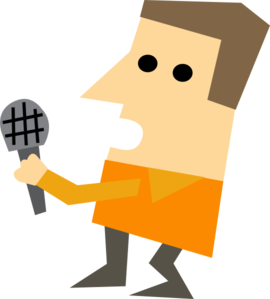
Education is changing worldwide. Technology has had its toll on the way we learn and teach. Governments fail to live up to their promises. But besides state-run schools and universities many new galaxies of learning have sprung up, whether in the form of private tutoring schools, online learning courses, digital textbooks and educational apps and devices.
In other words: the time is ripe for disruption! There’s a lot of positive developments happening in education right now and we’d like to hear your story!
Revisiting An Old IdeaFrom 2006 to 2007 I was doing an interview project in Berlin in which I went around asking different artists, thinkers and other noteworthy individuals the same 5 questions. The results were very unique short video interviews, filled with personal footage (and music) by the interviewees. Everyone liked the format and eventually we even had a little slot on the open cable television channel in Berlin (OKB) in which we broadcasted these multimedia portraits.
It was only recently that I stumbled over Leander Wattig – a German blogger who is very active in the publishing scene – and his blog interview series on wasmitbuechern.de in which he asks very different individuals in the publishing industry the same 5 questions.
I don’t know if the number 5 is a magic number, but it was great to see the principle of “same questions, different people” applied to writing, so I decided to reboot the old project in an educational context and offer anyone who wants to publish his or her text-based interview here on this blog.
If you want to participate simply write down and send your answers to the following questions to info {at} learnoutlive.com and include a picture of yourself. (Please note that we reserve the right to not publish all submissions)
1. Who are you and what do you do in education?
2. Describe a typical work day in your life!
3. In what way has technology in general and the net in particular changed your work?
4. What challenges do you see for education in the future?
5. Where can we find you online?
and now once again in color:

 About the author:
André Klein was born in Germany, has grown up and lived in many different places including Thailand, Sweden and Israel. He has produced two music albums, performed and organized literary readings, curated an experimental television program and is the author of various short stories and non-fiction works.
About the author:
André Klein was born in Germany, has grown up and lived in many different places including Thailand, Sweden and Israel. He has produced two music albums, performed and organized literary readings, curated an experimental television program and is the author of various short stories and non-fiction works.
September 7, 2012
How The Internet Shortens The Distance Between Learning And Doing

In my grandfather’s time most people used to spend only a few years in school, learning the basics of arithmetic and spelling, before starting to work and learning to make a living.
Today we spend more times in schools and universities than ever before.
And while on the one hand we’re becoming more and more knowledgeable, we also lose touch with the practical everyday reality of making a living.
Many young adults just keep on filling their heads with abstract data, while the prospect of real work lies dormant in the distant future, behind a wall of internships and letters of recommendations.
In this vacuum between, all kinds of strange plants grow. There might be expectations of riches, dreams of fame, or even days of despair – hanging suspended in vocation limbo.
It’s true that when young adults today want a high-paying job in a respectable company, they’ll need more education and experience than ever before. And it’ll take many years to collect these requirements, years that are lived only in regards to the benefits that may lie in the future.
Luckily, there’s an alternative to just “sitting it out”.
Everyone today can start utilizing the Internet to make a few bucks on the side, or even turn it into a full-time job.
Gone are the days in which “making money online” was but a ludicrous scheme. Today, there are many legitimate ways to sell products and services online, and it can be an interesting learning experience for students to start applying their talents and knowledge in real world scenarios.
Converting Assets Into CurrencyThe main principle is that a person can use the net to convert (mental) assets into valuable experience and cold hard cash. I like to think of these assets as natural tendencies or talents within a person. Mostly it’ll be necessary to learn additional skills to cash in on these assets, but usually they are easily acquired because there are many great tutorials available free of charge.
Writing
Got a good imagination? Always been spinning stories in your head? Why not write them down and put the best one on Amazon’s Kindle Direct Publishing program and see if you can make it sell? One sale could lead to ten, might inspire you to write more, and so on and so forth. more info »
Photography / Illustration
Always running around with a camera, snapping pictures of everything, or doodling elaborate patterns in class? Why not try to sell a few of your works to a site like istockphoto or turn your cute character design into a t-shirt concept with threadless.
(Language) teaching
Do you naturally speak a second language by birth? Why not help other people learn it through live language lessons via Skype? What works for languages works for other skills as well, whether it’s guitar playing or origami folding. more info »
Video
Do you like to entertain people with jokes and acting? Why not record a few of your antics, cut out the boring bits and upload it to YouTube? Even if you won’t get many views immediately, you’ll get valuable feedback that’ll help to improve your skills, increase your viewers and eventually maybe land you in the YouTube partner program that allows you to monetize your videos. more info »
Web-design
You’re a natural with Photoshop or HTML/CSS/PHP/Javascript? Why not start offering web-design services? Yes, the competition is big, but the need for people to have websites is even bigger, so if you think your sites are awesome, others might think the same!
Handcraft
You have a hand for working with wood, textiles or other materials to create unique designs and constantly surprise friends and family with your creativity? Why not upload a few of your works on etsy and see if you can make them sell?
NOTE:
The above ways are just a few examples, there are many more. As a final note, I wouldn’t expect to get rich quick from any of these. Doing any of these things as a full-time job will require a lot of time and energy. First and foremost, these are just ways to experiment and learn about one’s talents and skills while making a few bucks on the side. But who knows, once people get hooked on your stories, illustrations, comedy skits or custom handbags, and you receive positive feedback on a consistent basis, maybe you’ll even decide to do this full-time…
-
img: Some rights reserved by Jeannine St. Amand

 About the author:
André Klein was born in Germany, has grown up and lived in many different places including Thailand, Sweden and Israel. He has produced two music albums, performed and organized literary readings, curated an experimental television program and is the author of various short stories and non-fiction works.
About the author:
André Klein was born in Germany, has grown up and lived in many different places including Thailand, Sweden and Israel. He has produced two music albums, performed and organized literary readings, curated an experimental television program and is the author of various short stories and non-fiction works.
August 29, 2012
Print On Demand Revisited: Lulu vs. CreateSpace
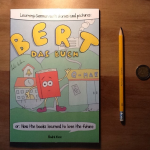 Before I started experimenting with creating ebooks for Kindle & Co last year, I briefly looked into print on demand services. Since in the pre-Internet days I had always been printing and xeroxing stories to share them with friends and family, I was only happy to find out that I could finally “outsource” my time spent in copy shops, and arguing with grumpy assistants over preferred bindings for various projects.
Before I started experimenting with creating ebooks for Kindle & Co last year, I briefly looked into print on demand services. Since in the pre-Internet days I had always been printing and xeroxing stories to share them with friends and family, I was only happy to find out that I could finally “outsource” my time spent in copy shops, and arguing with grumpy assistants over preferred bindings for various projects.
Basically, what a print on demand service does is to only print your books when someone orders them, contrary to “vanity publishing” where an author pays hundreds of thousands of dollars to order endless stacks of his own books which no shop will sell.
From The Screen Into Your HandsOne of these services is lulu.com, it was the first one I tried in the making of a poetry collection. To make a long story short, while it was amazing to see this book jump out of my computer and into my hands, the printing costs were relatively high, even for black & white only – so once global ebook sales started surging, I quickly abandoned my printing adventures and focused on ebook markets instead which allowed me to offer books at far lower prices (no printing & shipping costs) while the royalties were still higher.
CreateSpace: Low Cost, Full ImpactRecently, I decided to try out another well-known service in the print-on-demand field: CreateSpace. The company is owned by Amazon and promised a few things: quick distribution to their online stores, and most importantly: cheap production costs.
Since I had just finished a children’s book that dealt with the “war” between paper- and ebooks, ultimately making the point that both paper- and ebooks were great, I decided to transform it into print as a case study. Not only did the topic fit very well, but the interior of the book posed a few challenges to printers: It’s in full color and images need to cover the whole page up to the edge without a white border.
While it wasn’t easy at first to get everything right exactly the way I wanted, eventually it was all done and I ordered a test-copy which arrived today.
The result is better than I expected! I’ve created a little “unboxing” video for it and made a few photos which you can see below.
As for the prices, they were almost as nice as the printing quality. The production for this book (6 by 9 inch, full color softcover, 78 pages) came out at $10.52, and I’m selling it at $12.00 which leaves me with a royalty of $0.89. While this is of course in no way comparable to the prices & royalties in e-publishing, in comparison even authors who sell their novels on the Kindle store for $0.99 get about $0.34 per purchase.
Anyway, enough number-crunching. Enjoy the visuals!
If you want to find out more about the book, check it out on Amazon US | UK | DE | FR | ES | IT
P.S.: Keep in mind, if you commit yourself to book-making and getting rich is your primary motivation, pick a different job! I’m lucky enough to be able to make a modest living from writing and publishing alone, but my primary drive is and has always been the fascination of making things, not selling them.

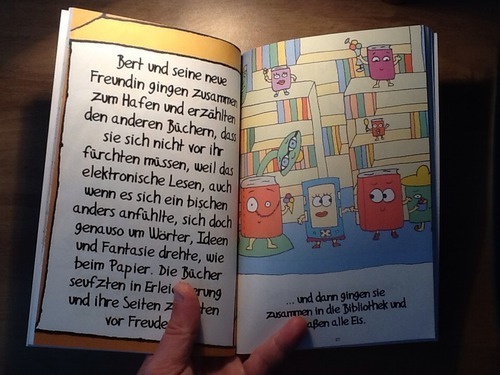
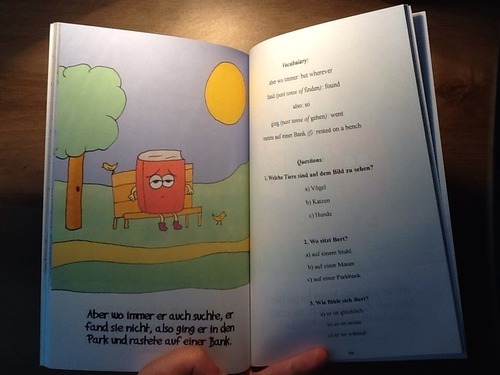
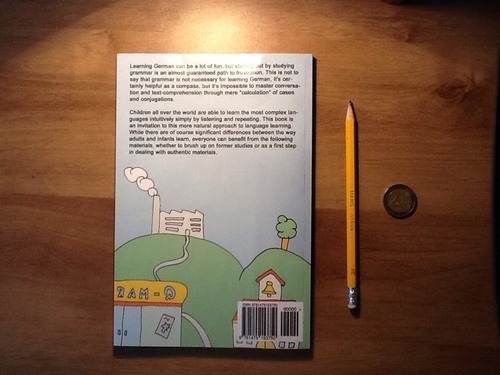

 About the author:
André Klein was born in Germany, has grown up and lived in many different places including Thailand, Sweden and Israel. He has produced two music albums, performed and organized literary readings, curated an experimental television program and is the author of various short stories and non-fiction works.
About the author:
André Klein was born in Germany, has grown up and lived in many different places including Thailand, Sweden and Israel. He has produced two music albums, performed and organized literary readings, curated an experimental television program and is the author of various short stories and non-fiction works.
August 26, 2012
The Great Big Giveaway: Get A Free Book In Exchange For A Review
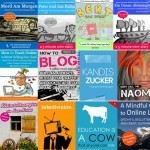 Attention everyone!
Attention everyone!
We’re looking for people who’d like to write honest reviews for our learning materials in exchange for a free copy.
For the next 2 weeks (ending 10th of September) you can participate. Tell your friends!
Who Can Participate?Anyone in the world with access to a computer, ereader, smartphone, etc. and an active Amazon account .
How Does It Work?It’s simple:
1. Go to our shop and browse for a book you’d like to review.
2. Fill in the form below
3. Receive an email with the book
4. Write a review within 24 days after receiving the email
Frequently Asked QuestionsQ: Why are you doing this?
As independent publishers we rely on the support of readers like you. This review exchange allows us to give something back to you and will help other readers make the right decision in selecting learning materials.
Q: Can I pick any of your books?
A: Almost. Excluded are the following titles: Kandis Zucker, Hebrew Alphabet Workbook, Good German Grammar Guide, Igool Ha Peleh, and Fred der Fisch.
Q: What should I write in the review?
A: Your review should be honest and not shorter than 20 words.
Q: But I’ve never written an Amazon review before. How does it work?
A: Here’s a video we’ve made for you that explains it in less than 50 seconds:
Request Your Free Review Copy[contact-form]

 About the author:
André Klein was born in Germany, has grown up and lived in many different places including Thailand, Sweden and Israel. He has produced two music albums, performed and organized literary readings, curated an experimental television program and is the author of various short stories and non-fiction works.
About the author:
André Klein was born in Germany, has grown up and lived in many different places including Thailand, Sweden and Israel. He has produced two music albums, performed and organized literary readings, curated an experimental television program and is the author of various short stories and non-fiction works.
August 22, 2012
Free Online Teaching Directory: Tutors Shouldn’t Pay For Listings
When I announced two months ago that we opened a directory for online tutors the response from teachers and tutors was very positive. Up to now many people have registered their online teaching websites and receive traffic from us every day.
When I told some friends and family about our online teaching directory where anyone can register freely, the first response was: “Why don’t you charge for it?”
Here’s why:
The Bad After-Taste Of Paying for Getting ListedWhen I started building my online teaching business I didn’t know where to turn first. I was even gullible enough to pay one site a few bucks for listing my name and contact . Of course they didn’t refer (serious) people and in the end I felt like I had fallen for a scam.
If a directory charges for listings, they’ll have to be able to guarantee paying students, which is very difficult, if not impossible.
You Can Buy People’s Attention, But You Can’t Buy Their LoveIn the old publishing paradigm only very few people had access to printing presses and a wide reader-ship. So they would charge an arm and a leg for running an ad, and people would pay.
When we watch TV or read a newspaper we are exposed to many advertisements and commercial messages. Whether they deserve our attention or not: they got it (to whatever degree) because they bought it.
This is why we don’t see many ads from the local vegetable shop or independent tutors around the corner.
In other words, the advertising model cannot be separated from a mass-media approach to publishing.
And it’s not as if there wasn’t an alternative! Online tutors have access to a variety of (free) tools that they can use to build a web presence without the need of paying for advertisements or a tutors directory.
Paying For Directory Listings Is Not A Substitute For LearningPaying for a listing on a tutors directory creates the expectation that teachers will now get a constant stream of paying students regardless of how their site and business are set up. So, instead of making an effort to finally get their head around the concept of SEO and Social Media, they pay. When the students don’t come, the bad aftertaste is guaranteed and there’s someone to blame: the teaching directory.
In other words: no money in the world can replace the knowledge and experience of building and marketing your own online teaching website and tying it into a broader Social Media effort.
It’s Not The Exposure, It’s What You Make Out Of ItIn the end, though, it’s not just about exposure. Even if online teaching websites receive a steady stream of traffic based on their SEO or Social Media efforts, there is always the question of what happens when a potential student visits.
Do they immediately find their way around the site?
Is it transparent how to contact the tutor for lessons?
Or do they just hit the “back” button and do something else.
….
An online teaching directory should be committed to quality first, not to making a quick buck! And I believe that by allowing people to register for free we are helping more teachers to develop their business than by charging for it.
What do you think?

 About the author:
André Klein was born in Germany, has grown up and lived in many different places including Thailand, Sweden and Israel. He has produced two music albums, performed and organized literary readings, curated an experimental television program and is the author of various short stories and non-fiction works.
About the author:
André Klein was born in Germany, has grown up and lived in many different places including Thailand, Sweden and Israel. He has produced two music albums, performed and organized literary readings, curated an experimental television program and is the author of various short stories and non-fiction works.
August 17, 2012
Crime Pays After All: Rediscovering A Classic Genre
 I was never much of a fan of books in the crime/mystery genre. While I grew up watching and enjoying famous German crime series on TV such as Tatort or Ein Fall für zwei, my reading and writing habits were developing along very different lines.
I was never much of a fan of books in the crime/mystery genre. While I grew up watching and enjoying famous German crime series on TV such as Tatort or Ein Fall für zwei, my reading and writing habits were developing along very different lines.
In elementary school, many of my friends were consuming books and audiobooks in which clubs of pre-teen detectives had to solve this or that (R-rated) dilemma. I didn’t understand the hype about it and preferred the eccentric adventures of Dr. Dolittle or Jim Button and Luke the Engine Driver. They had an element of surprise, containing everything from talking animals to giant magnetic cliffs.
In other words, it was the surreal and fantastic that caught my imagination early on. Even the fantasy genre seemed too predictable. The logic of dragons and sorcerers formed its own closed system of laws, even if it wasn’t as slavishly tied to “Real Life” as the detective genre.
After all, fiction is the ultimate sandbox. If you write the sentence: “A flock of pink cows passed the sun, their wings flapping in long broad strokes” an image appears in the mind’s eye, even if you’ve never seen winged bovines before.
As a teenager, my reading list was filled by cyberpunk science fiction such as Neuromancer and Snowcrash which also had a strong element of the surreal, even if the weirdness was couched in ‘scientific’ speculation.
A Change Of HeartIt was only very recently that I began to see the crime/mystery genre through different eyes. Always eager to discover new reading material, in early 2011 I was scouring the list of Wikipedia entries related to the famous Hugo and Nebula awards (important pointers in the sci-fi/fantasy genre) and stumbled over a book called The Yiddish Policemen’s Union.
Its story is ”set in an alternative history version of the present day, based on the premise that during World War II, a temporary settlement for Jewish refugees was established in Sitka, Alaska, in 1941, and that the fledgling State of Israel was destroyed in 1948. The novel is set in Sitka, which it depicts as a large, Yiddish-speaking metropolis.” (wiki)
This description alone was weird and surreal enough to get me excited. Little did I know that this novel by Michael Chabon was a brilliantly written detective story. In fact, it was the first literary crime story I ever encountered, full of psychological subtlety and sheer style.
A few months later I picked up another book which would change my opinion of the crime/mystery genre forever. And no, it was not Sir Arthur Conan Doyle’s Sherlock Holmes or Agatha Christie’s Murder on the Orient Express.
Instead, it was a novel by someone usually not associated with this genre at all: J.G. Ballard, infamous for his dystopian novels in which the planet either gets flooded (“The Drowned World”), scorched (“The Burning World”) or terrorized by psychopathic psychologists (“Kingdom Come”) and fundamentalist environmentalists (“Rushing To Paradise”).
Thus, when I picked up his novel Cocaine Nights (no, it’s not another book about drug addicts) I expected something similar, but instead I found it was a brilliantly thought out investigative novel about a man trying to free his brother from accusations of having burned down a house at the Spanish holiday paradise of Costa del Sol.
Even before I finished it I was completely hooked. When coupling an investigative plot with a strong literary style awesomeness could ensue after all!
So I started experimenting on my own with a little crime story designed for German learners. My surprise was not little when it shot to the Amazon bestseller lists and firmly lodged itself there.
After I was finished with it, I tore through Ballard’s Super-Cannes, a similar story like Cocaine Nights playing out in France, and went on a binge viewing of Hitchcock’s movies to learn more about the art of suspense.
Questioning AssumptionsI’m now convinced that the crime/mystery genre is a far better plot driver than pulp (one thing I always hated about cyberpunk) and allows for a lot of hallucinations and surreal encounters occurring on the fringe of the reader’s awareness. In the end, it’s the subtlety that amplifies the effect. While you have real people obeying real world physical laws, the process of catching a killer or solving a crime becomes a journey into the human psyche that leads the reader to question his assumptions.
Great books can do that! They make you investigate your beliefs and convictions. And what genre is more predestined to do that than the one of investigative fiction?
I for one am certainly cured of my long-held bias towards detective stories as “light entertainment” and I’ve just released a second crime story in German, myself. It’s a lot of fun, and while I’m certainly no master of this genre, yet, I am confident that German learners will benefit from the use of natural language, vocabulary guide and Q&A.
If you’re interested in these stories, check out the links below:
Mord Am Morgen – a detective story for German language learners
Die Dritte Hand – a detective story for German language learners
What about you? Do you think that detective stories are mostly cheap thrills or deserve their place among the ranks of high literature?

 About the author:
André Klein was born in Germany, has grown up and lived in many different places including Thailand, Sweden and Israel. He has produced two music albums, performed and organized literary readings, curated an experimental television program and is the author of various short stories and non-fiction works.
About the author:
André Klein was born in Germany, has grown up and lived in many different places including Thailand, Sweden and Israel. He has produced two music albums, performed and organized literary readings, curated an experimental television program and is the author of various short stories and non-fiction works.

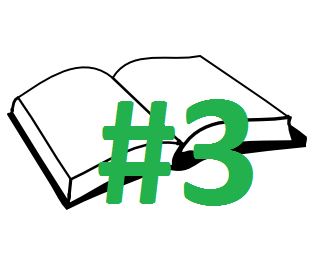 [
[







